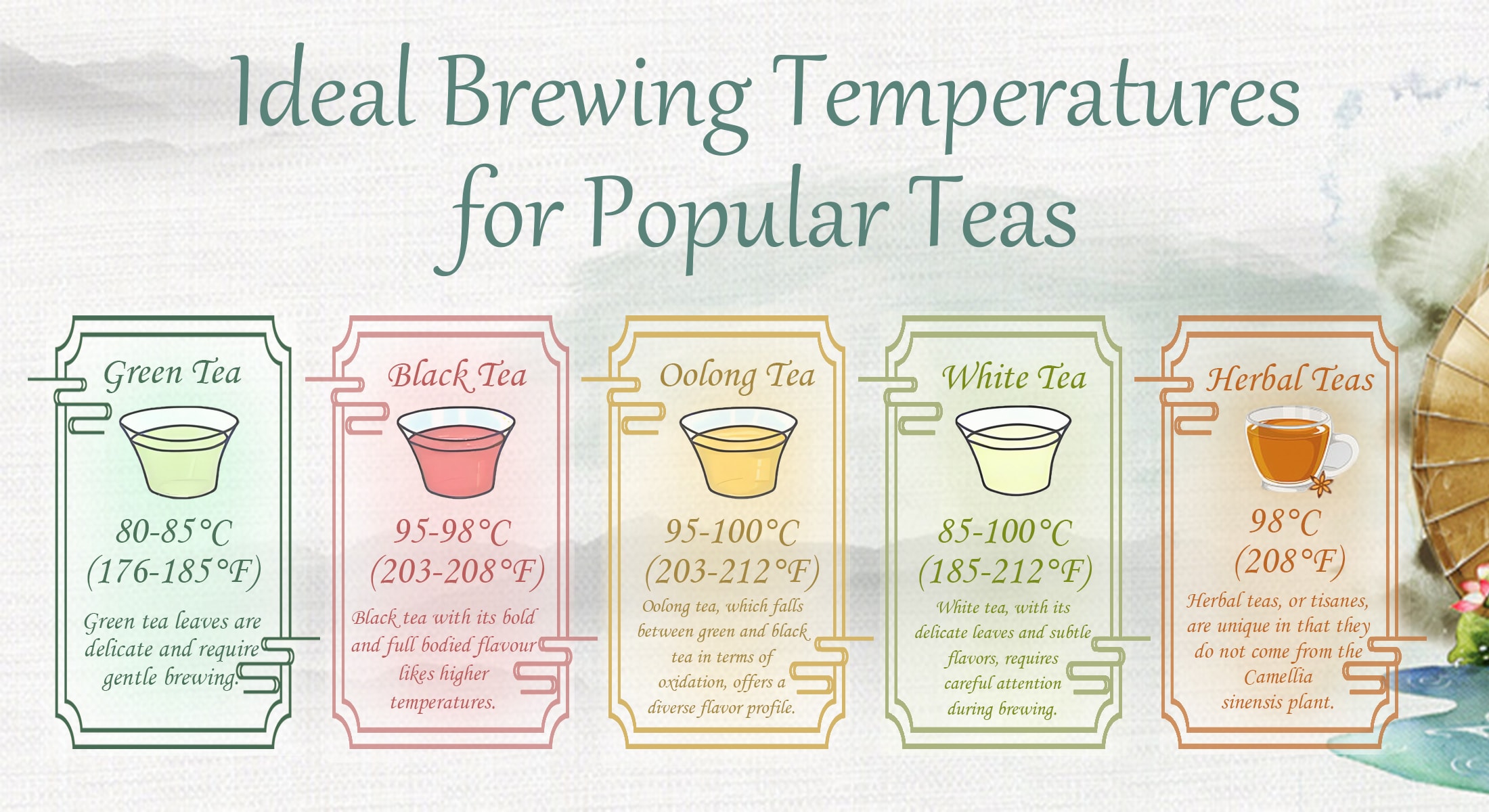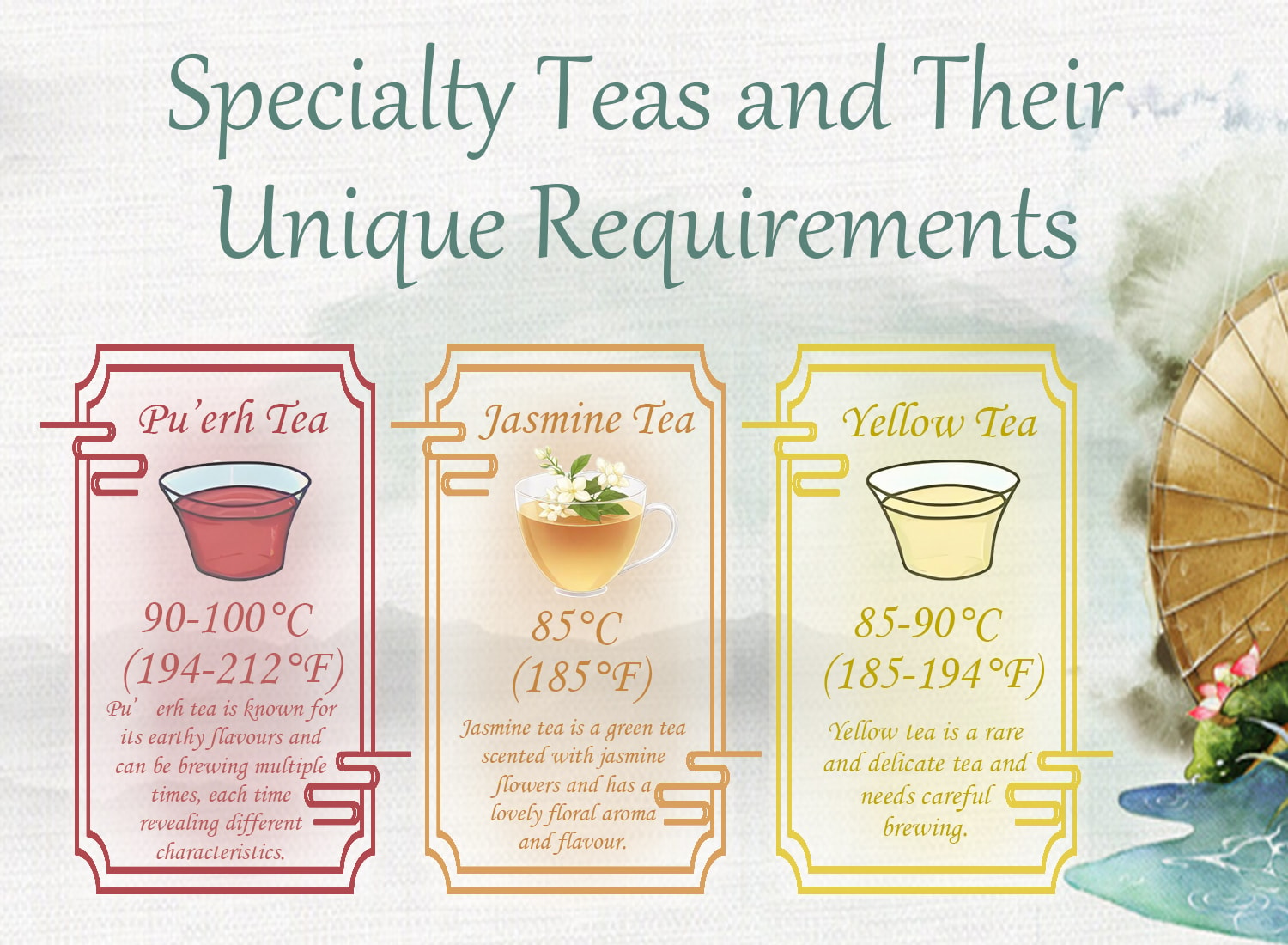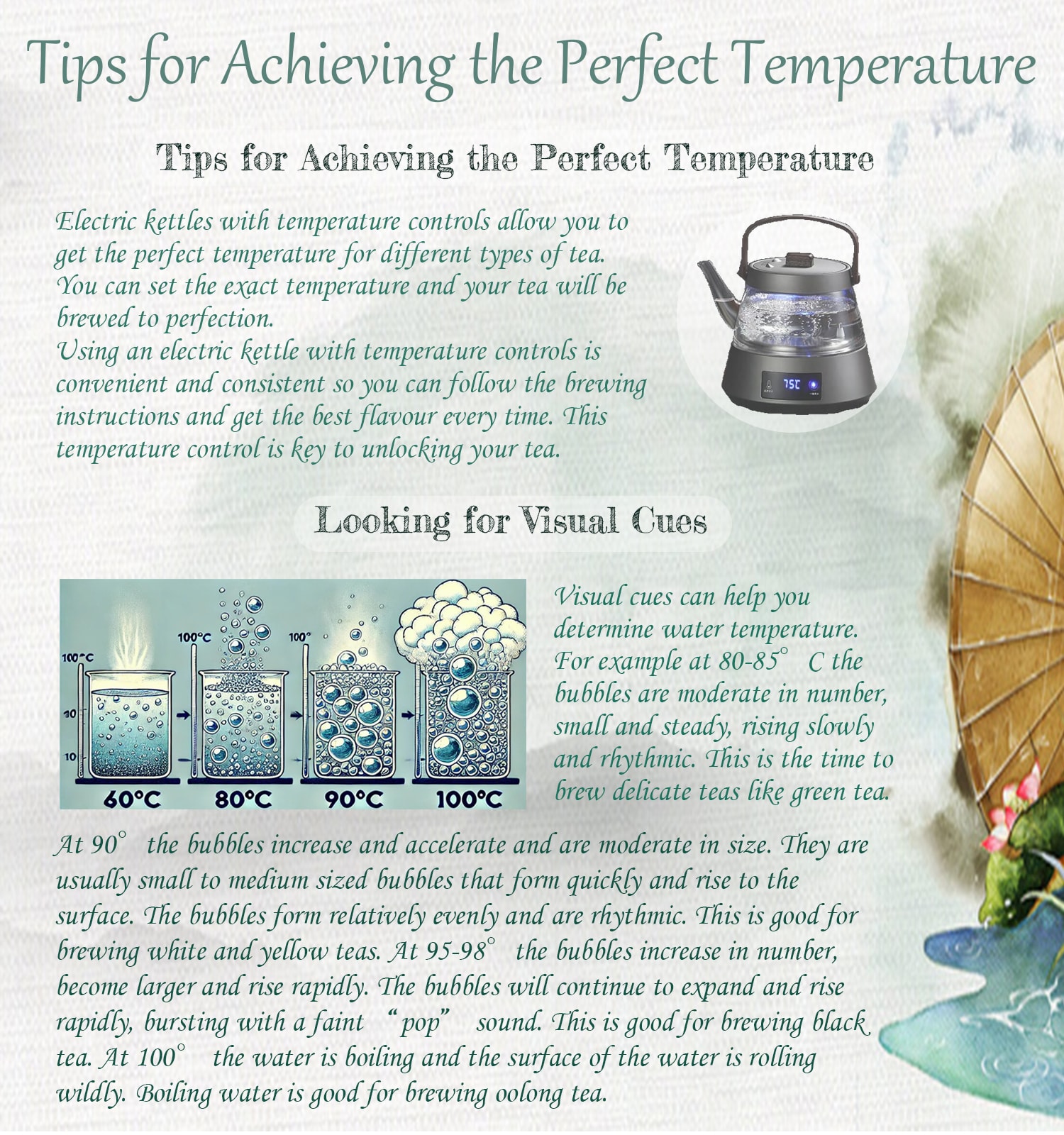
Perfect Temperature for Tea: Mastering the Best Brew Every Time
liujiehangShare
Before diving into this topic, you may want to explore our complete brewing guide:
Tea Brewing and Storage Guide – Learn How to Brew and Store Tea for the Best Flavor and FreshnessThis article is part of that series and expands on one specific step to help you brew better tea at home.
Discovering the perfect temperature for tea is essential for an excellent brew. Green, black, white, and oolong teas each have unique temperature needs to bring out their best flavors. This article provides the ideal temperatures and tips to help you brew each type of tea perfectly.
- Each type of tea requires specific water temperatures to enhance its flavors and avoid bitterness, such as 75-80°C for green tea and 95-98°C for black tea.
- Over-extraction due to incorrect water temperature can lead to bitterness; therefore, understanding the temperature guidelines is crucial for brewing a perfect cup.
- Using tools like thermometers and electric kettles with temperature settings can help achieve precise brewing temperatures, elevating the tea-drinking experience.
Understanding the Impact of Water Temperature on Tea

Water temperature is more than just a number on a thermometer; it’s the key to a perfect cup of tea.Using loose leaf tea is essential for achieving the best flavor, as it requires precise temperature control. Each type of tea—green, black, white or oolong—has a temperature range that brings out its best flavours and aromas. The right temperature can make the difference between a good cup and a bad one.
Temperature control is key to the flavour profile of different teas. For example green and white teas need slightly cooler water to avoid bitterness, black and herbal teas love nearly boiling water. Adjust the water temperature to the type of tea for optimal flavour release and the best tea drinking experience.
The Science of Tea Brewing
Brewing is all about heat and time. Too hot and you get over-extraction and too many tannins and a bitter taste. Too cold and not enough extraction and the tea is weak and boring. The sweet spot is where the water temperature matches the tea’s needs and the perfect balance of flavours comes out. Loose leaf tea requires specific measurements per cup and precise steeping times for the best results.
Different teas require different brewing instructions because of their unique make up. Green teas and white teas have delicate leaves and need lower temperatures to prevent scalding, black teas and herbal infusions need higher temperatures to fully extract their strong flavours. This temperature control is key to getting a perfect cup as it determines what flavour compounds are extracted from the tea leaves.
Adjusting the brewing temperature changes the flavour intensity and strength so you can tailor the brew to your taste. Experiment with different temperatures and find the perfect brewing process for you and every cup will be a customised delight.
Avoiding Bitterness in Your Cup
Nothing ruins a cup of tea faster than an unexpected bitter taste. To prevent this, it’s crucial to adhere to the recommended steeping times and temperatures for each tea variety. For example, green tea’s optimal brewing temperature typically ranges from 80-85°C (176-185°F), allowing its delicate flavors to shine without over-extraction.
White teas are best brewed at lower temperatures of 85-100°C (185-212°F) to avoid scalding the leaves and to maintain their subtle flavor profile. Starting with lower temperatures can also prevent over-extraction of flavors, helping to maintain a smoother taste. Carefully following these guidelines ensures a perfect, bitterness-free cup of tea every time.
Ideal Brewing Temperatures for Popular Teas
Different teas have distinct optimal brewing temperatures, which are essential for unlocking their unique flavors and aromas. Using loose leaf tea can help achieve these ideal brewing temperatures and enhance the tea's flavors. Understanding and using these specific temperatures can elevate your tea-drinking experience, making each cup a true reflection of the tea’s character.
Here are the ideal temperatures for some of the most popular types of tea.

Green Tea
Green tea with its delicate leaves requires a gentle touch. To keep its subtleties and not bitterness brew green tea between 80-85°C (176-185°F).This temperature range ensures that the tea leaves do not scald, preserving their natural sweetness and complexity.
Green teas should be steeped for 1-4 minutes to get the perfect balance of flavour and aroma. Following these guidelines will get you a lovely cup of green tea every time.
Black Tea
Black tea with its bold and full bodied flavour likes higher temperatures. The ideal brewing temperature for black tea is 95-98°C (203-208°F). This high temperature allows the tea leaves to unfurl and release all its rich flavours.
Brewing black tea at this temperature brings out its full strength and depth and every sip is a pleasure. Whether its a classic English Breakfast or afragrant Earl Grey, using the right temperature is the key to get the best out of it.
Oolong Tea
Oolong tea, which falls between green and black tea in terms of oxidation, offers a diverse flavor profile. Depending on whether the oolong is light or dark, it can be brewed at a temperature range of 95-100°C (203-212°F). This flexibility allows you to tailor the brew to either emphasize its floral and fruity notes or its more robust, roasted flavors.
Steeping oolong tea within this temperature range caters to both its light and dark varieties, ensuring a delightful and balanced cup. Experimenting within this range reveals the unique characteristics of oolong tea.
White Tea
White tea, with its delicate leaves and subtle flavors, requires careful attention during brewing. The ideal temperature range for white tea is 85-100°C (185-212°F) . This lower temperature prevents the leaves from scalding and allows their gentle flavors to shine through.
Herbal Teas
Herbal teas, or tisanes, are unique in that they do not come from the Camellia sinensis plant. These caffeine-free infusions are best brewed at 98°C (208°F) to fully extract their rich and varied flavors. Herbal tea is enjoyed by many for its diverse benefits.
Brewing herbal teas at this high temperature ensures that all the beneficial compounds and flavors from the herbs, flowers, or fruits are fully released. Whether you’re enjoying a calming chamomile, a zesty peppermint, or a cup of hot tea, the right temperature will enhance your tea-drinking experience.
Specialty Teas and Their Unique Requirements
Specialty teas, with their unique flavors and aromas, require precise brewing temperatures to unlock their full potential. These teas often have specific temperature ranges that must be adhered to for optimal flavor extraction.
Here, we explore the ideal temperatures for some popular specialty teas.

Pu’erh Tea
Pu’erh tea is known for its earthy flavours and can be brewing multiple times, each time revealing different characteristics. To brew pu’erh tea optimally, the water temperature should be between 90-100°C (194-212°F).
With each infusion, pu’erh tea changes flavours, so by following these temperature guidelines you can fully experience the depth of pu’erh tea.
Jasmine Tea
Jasmine tea is a green tea scented with jasmine flowers and has a lovely floral aroma and flavour. For best results jasmine tea should be brewed at 85°C (185°F).
Steeping time for jasmine tea is 2-3 minutes which ensures the delicate floral notes are expressed without being overpowering.
Yellow Tea
Yellow tea is a rare and delicate tea and needs careful brewing. The recommended temperature for yellow tea is 85-90°C (185-194°F). Brewing yellow tea at the right temperature preserves its taste and aroma, so each cup is refined and exquisite.
Tips for Achieving the Perfect Temperature

Achieving the ideal water temperature is crucial for optimal tea brewing, as it enhances flavor and prevents bitterness, especially when using hot water. Using loose leaf tea can help achieve precise temperature control and enhance the overall tea-drinking experience.
Here are some practical tips to help you reach the perfect temperature for your tea.
Electric Kettles with Temperature Controls
Electric kettles with temperature controls allow you to get the perfect temperature for different types of tea. You can set the exact temperature and your tea will be brewed to perfection.
Using an electric kettle with temperature controls is convenient and consistent so you can follow the brewing instructions and get the best flavour every time. This temperature control is key to unlocking your tea.
Looking for Visual Cues
Visual cues can help you determine water temperature. For example at 80-85°C the bubbles are moderate in number, small and steady, rising slowly and rhythmic. This is the time to brew delicate teas like green tea.
At 90°C the bubbles increase and accelerate and are moderate in size. They are usually small to medium sized bubbles that form quickly and rise to the surface. The bubbles form relatively evenly and are rhythmic. This is good for brewing white and yellow teas. At 95-98°C the bubbles increase in number, become larger and rise rapidly. The bubbles will continue to expand and rise rapidly, bursting with a faint “pop” sound. This is good for brewing black tea. At 100°C the water is boiling and the surface of the water is rolling wildly. Boiling water is good for brewing oolong tea.
Mastering the optimal temperature for brewing tea is both an art and a science. With knowledge of how water temperature affects tea you can enjoy your favourite teas at their best, every time. From green and white teas that need cooler water to black and herbal teas that need near boiling water to brew, each tea has its own requirements.
By experimenting with temperature and paying attention to the specific needs of each tea you can find the perfect conditions for your taste. Whether you use an electric kettle with temperature control or a visual cue you’ll elevate your tea drinking to a whole new level.
If you want to explore the full picture — from temperature and ratios to freshness and long-term storage — you can continue reading the main guide here:
Tea Brewing and Storage Guide – Learn How to Brew and Store Tea for the Best Flavor and FreshnessIt connects all the essential brewing principles and shows how each step works together to create a smoother, more flavorful cup.









